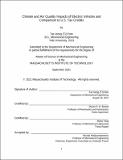| dc.description.abstract | Road transportation is the largest contributor to CO2 and second largest contributor to early deaths from air pollution in the U.S. To decarbonize and meet its contribution to the Paris Agreement goal of global average temperature rise <2°C and curb human health impacts from air quality, the U.S. must reduce its road sector emissions. Electrification of the light duty vehicle fleet is a potential solution, and the federal government is offering a $7,500 tax credit, along with 15 states with up to $5,000 rebates on battery electric vehicle (BEV) purchases. This study compares the monetized climate and air quality impacts of driving a BEV over a gasoline internal combustion engine vehicle (ICEV) for its full useful life to the federal and state subsidies in the 48 contiguous states. This comparison is an indicator of how well matched the subsidies are to the potential benefits. I use driving patterns across urban, suburban, and rural regions in addition to ICEV and BEV emission factors to compile an emissions inventory across vehicle sizes, trims, and model years. I convert the air pollution emissions to early deaths using new mortality scaling factors calculated from previous work. I determine the monetized climate impacts using the social cost of carbon, and the air quality impacts using mean value of a statistical life. I find that for a new base trim non-luxury compact SUV, the BEV is on average a $1,212 benefit for climate in 46 states, $1,555 benefit for air quality in 32 states, and a combined average of $2,391 benefit in 42 states. The climate and air quality benefit is smaller than the federal and state subsidy in all states by an average of $6,320, except in New Jersey where the benefit is larger by $30. In states where there are BEV damages over an ICEV, no state subsidy is offered. I find that the average combined BEV benefit is positive in all states and 3.8 times larger for a top trim large luxury sedan than a base trim non-luxury compact SUV, due to minimal efficiency penalties for higher performance from upgrading to top trims for BEVs compared to ICEVs. I also find that ammonia (NH3) dominates the total damages, contributing to 56% and 37% for ICEVs and BEVs, respectively, in Massachusetts for example. Three-way catalytic converters (TWC) in gasoline ICEVs produce NH3, while selective catalytic reduction (SCR) used in power plants exhibit ammonia slip, both of which reduce nitrogen oxides (NOx). The northeast and west coast states have higher benefits while midwestern states have smaller benefits or damages from BEVs. Careful evaluation is needed to avoid climate and air quality damages from BEVs when considering expansion and/or extension of the federal subsidy due to regional disparities in emissions of the electric grid. This highlights the importance of emissions reduction from the electric grid along with vehicle fleet electrification. | |
